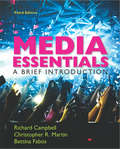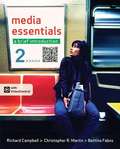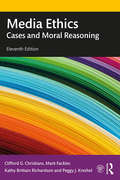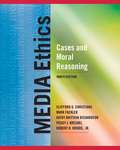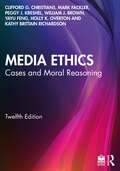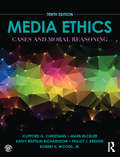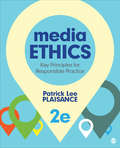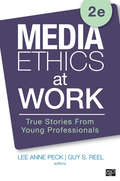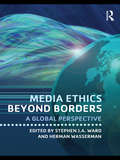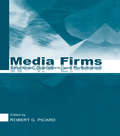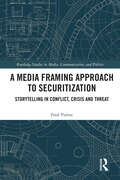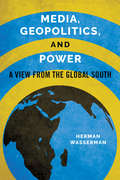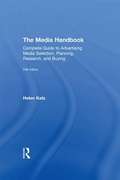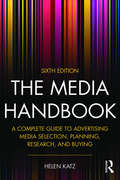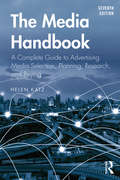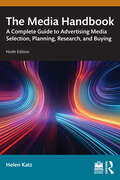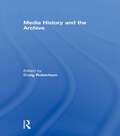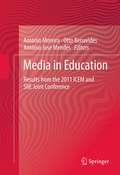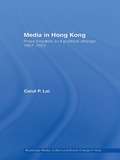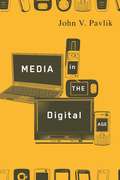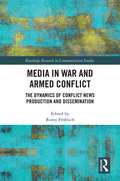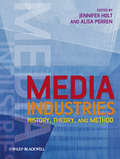- Table View
- List View
Media Essentials
by Richard Campbell Bettina Fabos Christopher R. Martin Shawn HarmsenMedia Essentials focuses on the most pivotal aspects of mass communication, and its new edition is more effective than ever at helping students understand the everchanging mass-media landscape. It features new Media Convergence and Media Literacy boxes plus specific, detailed case studies; a newly integrated chapter on the history of journalism; and an expanded program of video clips on LaunchPad that drive home the book's approach to media literacy and analysis.
Media Essentials: A Brief Introduction (Second Edition)
by Richard Campbell Christopher Martin Bettina FabosMedia Essentials focuses on the fundamentals of mass communication, helping students keep pace with today's rapidly evolving and converging media. Best-selling authors Richard Campbell, Christopher R. Martin, and Bettina Fabos distill the essential information on media industries and major concepts, incorporate their accessible critical approach, and give students all the study tools they need to succeed in the course and be savvy media consumers. For the second edition of Media Essentials, the authors have added and enriched coverage of media topics instructors asked for, including videogames, convergence, media literacy, streaming music, online journalism, and more. This all comes together in a brief, attractive format -- for a very attractive price, about 50% less than competing texts.
Media Ethics: Cases and Moral Reasoning
by Clifford G. Christians Mark Fackler Kathy Brittain Richardson Peggy KreshelMedia Ethics: Cases and Moral Reasoning challenges readers to think analytically about ethical situations in mass communication through original case studies and commentaries about real-life media experiences. This text provides a comprehensive introduction to the theoretical principles of ethical philosophies, facilitating ethical awareness. It introduces the Potter Box, with its four dimensions of moral analysis, to provide a framework for exploring the steps in moral reasoning and analyzing the cases. Focusing on a wide spectrum of ethical issues faced by media practitioners, the cases in this Eleventh Edition include the most recent issues in journalism, broadcasting, advertising, public relations and entertainment. Cases touch on issues and places worldwide, from Al Jazeera to the Xinhua News Agency, from Nigerian "brown envelopes" to PR professional standards in South Africa. Racially divisive language comes up in different communication contexts, as does celebrity influence on culture. A core textbook for classes in media ethics, communication ethics, and ethics in journalism, public relations, and advertising. The companion website [url] contains sample syllabi and lesson plans, PowerPoint presentations, discussion and test questions, and a library of video and other media materials for class use.
Media Ethics: Cases and Moral Reasoning, CourseSmart eTextbook
by Clifford G. Christians Mark Fackler Kathy Richardson Peggy Kreshel Robert H. WoodsMedia Ethics: Cases and Moral Reasoning, Ninth Edition challenges students to think analytically about ethical situations in mass communication by using original case studies and commentaries about real-life media experiences. This market-leading text facilitates and enhances students' ethical awareness by providing a comprehensive introduction to the theoretical principles of ethical philosophies. Media Ethics introduces the Potter Box (which uses four dimensions of moral analysis: definitions, values, principles and loyalties) to provide a framework for exploring the important steps in moral reasoning and analyzing the cases that follow. Focusing on a wide spectrum of ethical issues facing media practitioners, the cases in this new Ninth Edition include the most recent issues in journalism, broadcasting, advertising, public relations and entertainment.
Media Ethics: Cases and Moral Reasoning
by Mark Fackler William J. Brown Clifford G. Christians Kathy Brittain Richardson Peggy J. Kreshel Yayu Feng Holly K. OvertonThrough original case studies and analyses of real-life media experiences, Media Ethics challenges readers to think analytically and critically about ethical situations in mediated communication.This textbook provides a comprehensive introduction to the theoretical principles of ethical philosophies, facilitating awareness and critical reflection of ethical issues. In each chapter, the authors examine case studies spanning several continents and geopolitical and cultural contexts. To provide a framework for analyzing the cases and exploring the steps in moral reasoning, the book introduces the Potter Box, a powerful tool for moral analysis. Focusing on a wide range of ethical issues faced by media practitioners and news organizations, the cases in this new twelfth edition include the most prominent concerns in journalism, broadcasting, advertising, public relations, and entertainment today. It explores new topics such as the use of ChatGPT in newsrooms, the privacy implications of biometric technologies, the role of public relations in political campaigns, and advertisers’ approach to sustainability and climate change.This core textbook is ideal for classes in media and communication ethics, journalism, public relations, advertising, entertainment media, and popular culture.Online instructor and student resources, including video introductions to each chapter, PowerPoint slides, sample discussion and exam questions, and links to further resources, are available at www.routledgelearning.com/mediaethics.
Media Ethics: Cases and Moral Reasoning
by Mark Fackler Clifford G. Christians Kathy Brittain Richardson Peggy Kreshel Robert H. WoodsMedia Ethics: Cases and Moral Reasoning challenges readers to think analytically about ethical situations in mass communication through original case studies and commentaries about real-life media experiences. This text provides a comprehensive introduction to the theoretical principles of ethical philosophies, facilitating ethical awareness. It introduces the Potter Box, with its four dimensions of moral analysis, to provide a framework for exploring the steps in moral reasoning and analyzing the cases. Focusing on a wide spectrum of ethical issues faced by media practitioners, the cases in this Tenth Edition include the most recent issues in journalism, broadcasting, advertising, public relations, and entertainment. Visit the companion website at http://www.mediaethicsbook.com/.
Media Ethics: Key Principles for Responsible Practice
by Dr Patrick L. PlaisanceMedia Ethics: Key Principles for Responsible Practice makes ethics accessible and applicable to media practice, and explains key ethical principles and their application in print and broadcast journalism, public relations, advertising, marketing, and digital media. Unlike application-oriented casebooks, this text sets forth the philosophical underpinnings of key principles and explains how each should guide responsible media behavior. Author Patrick Lee Plaisance synthesizes classical and contemporary ethics in an accessible way to help students ask the right questions and develop their critical reasoning skills, as both media consumers and media professionals of the future. The Second Edition includes new examples and case studies, expanded coverage of digital media, and two new chapters that distinguish the three major frameworks of media ethics and explore the discipline across new media platforms, including blogs, new forms of digital journalism, and social networking sites.
Media Ethics at Work: True Stories from Young Professionals
by Dr Lee Anne Peck Dr Guy S. ReelA fresh approach to building integrity in all media Media Ethics at Work: True Stories from Young Professionals (By Lee Anne Peck and Guy S. Reel) transforms students into confident, self-reliant, and ethical decision makers, prepared to resolve moral dilemmas from day one of their first media job or internship. The highly anticipated Second Edition of this text continues to engage students with true stories of young professionals working in today’s multimedia news and strategic communications organizations, helping readers create meaningful connections to real-world applications. Each story is presented as a narrative, so students can work through the ethical dilemmas as they unfold, encouraging readers to think about and ask the question: “What would I do if this happened to me?” By creating a more personalized experience for students beginning their first entry-level media jobs or internship, this book helps readers develop their own ethical standards and apply in the workplace what they have learned.
Media Ethics at Work: True Stories from Young Professionals
by Dr Lee Anne Peck Dr Guy S. ReelA fresh approach to building integrity in all media Media Ethics at Work: True Stories from Young Professionals (By Lee Anne Peck and Guy S. Reel) transforms students into confident, self-reliant, and ethical decision makers, prepared to resolve moral dilemmas from day one of their first media job or internship. The highly anticipated Second Edition of this text continues to engage students with true stories of young professionals working in today’s multimedia news and strategic communications organizations, helping readers create meaningful connections to real-world applications. Each story is presented as a narrative, so students can work through the ethical dilemmas as they unfold, encouraging readers to think about and ask the question: “What would I do if this happened to me?” By creating a more personalized experience for students beginning their first entry-level media jobs or internship, this book helps readers develop their own ethical standards and apply in the workplace what they have learned.
Media Ethics Beyond Borders: A Global Perspective
by Stephen J.A. WardThis volume explores the construction of an ethics for news media that is global in reach and impact. Essays by international media ethicists provide leading theoretical perspectives on major issues and applies the ideas to specific countries, contexts and problems, addressing such questions as: Are there universal values in journalism? How would a global media ethics do justice to the cultural, political, and economic differences around the world? Can a global ethic based on universal principles allow for diversity of media systems and cultural values? What should be the principles and norms of practice of global media ethics? The result is a rich source of ethical thought and analysis on questions raised by contemporary global media.
Media Firms: Structures, Operations, and Performance
by Robert G. PicardMedia Firms presents studies applying the company level approach to media and communication firms. It explores differences among missions, strategies, organizational choices, and other business decisions. Reviewing economic factors and pressures on media and communications companies, this book seeks to improve understanding of how these elements affect market and company structures, operations, and performance of firms. The chapters, written by leading scholars worldwide, were selected from papers on the theme of media firms presented at the 5th World Media Economics Conference hosted by the Turku School of Economics and Business Administration and The Journal of Media Economics. The collected studies provide: *an overview of economic and related managerial issues affecting the structures of markets in which firms compete; *the operations of media and communications firms; and *their financial performance. As a result, it expands the discussion of economic issues traditionally associated with the field due to narrowed focus of initial books in media economics. It is hoped that this book will induce additional avenues of inquiry regarding such issues.
A Media Framing Approach to Securitization: Storytelling in Conflict, Crisis and Threat (Routledge Studies in Media, Communication, and Politics)
by Fred VulteePresenting securitization as a communication issue, this book combines media framing with the theory of securitization to explain how the discourse of security informs media content and what happens to policy and public understanding when it does. Because securitization studies the construction of threats to societal structures as well as political-institutional structures, this book addresses security framing as a question of identity and the ability of political-cultural elites and media actors to manipulate it. After setting out how its theories work together, the book turns to news and its effects: How do media accounts make empirical sense of the world when they are bound by the need to make social-cultural sense first? How does "security" look in competing news accounts, and how do securitizing frames affect attitudes toward policies and political elites? Last, the book asks how academics and professionals can address the challenges to a democratic public’s role in decision-making created by the manipulation of security. Bringing together distinct fields within communication studies to reflect on the pressing issue of securitization, this book will be a key resource for scholars and students working in the fields of mass communication, policy studies, critical linguistics and international relations, as well as risk and crisis communication.
A Media Framing Approach to Securitization: Storytelling in Conflict, Crisis and Threat (Routledge Studies in Media, Communication, and Politics)
by Fred VulteePresenting securitization as a communication issue, this book combines media framing with the theory of securitization to explain how the discourse of security informs media content and what happens to policy and public understanding when it does. Because securitization studies the construction of threats to societal structures as well as political-institutional structures, this book addresses security framing as a question of identity and the ability of political-cultural elites and media actors to manipulate it. After setting out how its theories work together, the book turns to news and its effects: How do media accounts make empirical sense of the world when they are bound by the need to make social-cultural sense first? How does "security" look in competing news accounts, and how do securitizing frames affect attitudes toward policies and political elites? Last, the book asks how academics and professionals can address the challenges to a democratic public’s role in decision-making created by the manipulation of security.Bringing together distinct fields within communication studies to reflect on the pressing issue of securitization, this book will be a key resource for scholars and students working in the fields of mass communication, policy studies, critical linguistics and international relations, as well as risk and crisis communication.
Media, Geopolitics, and Power: A View from the Global South (Geopolitics of Information)
by Herman WassermanThe end of apartheid brought South Africa into the global media environment. Outside companies invested in the nation's newspapers while South African conglomerates pursued lucrative tech ventures and communication markets around the world. Many observers viewed the rapid development of South African media as a roadmap from authoritarianism to global modernity. Herman Wasserman analyzes the debates surrounding South Africa's new media presence against the backdrop of rapidly changing geopolitics. His exploration reveals how South African disputes regarding access to, and representation in, the media reflect the domination and inequality in the global communication sphere. Optimists see post-apartheid media as providing a vital space that encourages exchanges of opinion in a young democracy. Critics argue the public sphere mirrors South Africa's past divisions and privileges the viewpoints of the elite. Wasserman delves into the ways these simplistic narratives obscure the country's internal tensions, conflicts, and paradoxes even as he charts the diverse nature of South African entry into the global arena.
The Media Handbook: A Complete Guide to Advertising Media Selection, Planning, Research, and Buying
by Helen KatzThe Media Handbook provides a practical introduction to the advertising media planning and buying process. Emphasizing basic calculations along with the practical realities of offering alternatives and evaluating the plan, this fifth edition reflects the critical changes in how media is planned, bought, and sold by today's industry professionals. Author Helen Katz looks at the larger marketing, advertising, and media objectives, and follows with an exploration of major media categories, including digital media. She provides a comprehensive analysis of planning and buying, with a continued focus on how those tactical elements tie back to the strategic aims of the brand and client. Also available is a Companion Website that expands The Media Handbook's content in an online forum. Here, students and instructors can find tools to enhance course studies such as chapter overviews, PowerPoint slides, and sample questions. With its emphasis on real-world industry practice, The Media Handbook provides an essential introduction to students in advertising, media planning, communication, and marketing. It serves as an indispensable reference for anyone pursuing a career in media planning, buying, and research.
The Media Handbook: A Complete Guide to Advertising Media Selection, Planning, Research, and Buying (Lea’s Communication Series)
by Helen KatzThe Media Handbook provides a practical introduction to the advertising media planning and buying processes. Emphasizing basic calculations and the practical realities of offering alternatives and evaluating the plan, this sixth edition reflects the critical changes in how advertising in various media is planned, bought, and sold by today’s industry professionals. Author Helen Katz looks at the larger marketing, advertising, and media objectives, and follows with an exploration of major media categories, covering paid, owned, and earned media forms, including digital media. She provides a comprehensive analysis of planning and buying, with a continued focus on how those tactical elements tie back to the strategic aims of the brand and the client. Also available is a Companion Website that expands The Media Handbook’s content in an online forum. Here, students and instructors can find tools to enhance course studies such as chapter overviews, PowerPoint slides, and sample questions. With its emphasis on real-world industry practice, The Media Handbook provides an essential introduction to students in advertising, media planning, communication, and marketing. It serves as an indispensable reference for anyone pursuing a career in media planning, buying, and research.
The Media Handbook: A Complete Guide to Advertising Media Selection, Planning, Research, and Buying (Routledge Communication Series)
by Helen KatzThe Media Handbook provides a practical introduction to the advertising, media planning, and buying processes. Emphasizing basic calculations and the practical realities of offering alternatives and evaluating the plan, this seventh edition includes greater coverage of social media, buying automation, the continued digitization of media, and updated statistics on media consumption. It covers over the top television, programmatic TV, digital advertising, and the automation of buying across all media. Author Helen Katz provides a continued focus on how planning and buying tie back to the strategic aims of the brand and the client, keeping practitioners and students up to date with current industry examples and practices. The Companion Website to the book includes resources for both students and instructors. For students there are flashcards to test themselves on main concepts, a list of key media associations, a template flowchart and formulas. Instructors can find lecture slides and sample test questions to assist in their course preparation.
The Media Handbook: A Complete Guide to Advertising Media Selection, Planning, Research, and Buying (Routledge Communication Series)
by null Helen KatzNow in its 9th edition, The Media Handbook introduces students to the media planning and buying process with a concise and industry-informed approach.The book takes readers through the fundamentals of each media channel, leading to the creation of a media plan. This edition features a revised and expanded chapter on digital media for both planning and buying (including programmatic), with additional material on artificial intelligence, the metaverse and augmented/virtual reality, and streaming. It also includes more charts and tables to provide additional visual appeal and understanding. Newly updated data, more international brand examples, and a summary of key media calculations round out this thoroughly updated edition.This text remains ideal for courses in media planning and buying in advertising and mass communication departments.Supplemental online resources for both students and instructors are also available. To assist in their course preparation, instructors will find lecture slides and sample test questions while students will benefit from chapter overviews and new sample media planning exercise scenarios with accompanying practice spreadsheets. Please visit www.routledge.com/9781032671369.
Media History and the Archive
by Craig RobertsonBy the time readers encounter academic history in the form of books and articles, all that tends to be left of an author’s direct experience with archives is pages of endnotes. Whether intentionally or not, archives have until recently been largely thought of as discrete collections of documents, perhaps not neutral but rarely considered to be historical actors.This book brings together top media scholars to rethink the role of the archive and historical record from the perspective of writing media history. Exploring the concept of the archive forces a reconsideration of what counts as historical evidence. In this analysis the archive becomes a concept that allows the authors to think about the acts of classifying, collecting, storing, and interpreting the sources used in historical research. The essays included in this volume, from Susan Douglas, Lisa Gitelman, John Nerone, Jeremy Packer, Paddy Scannell, Lynn Spigel, and Jonathan Sterne, focus on both the theoretical and practical ways in which the archive has affected how media is thought about as an object for historical analysis.This book was published as a special issue of The Communication Review.
Media in Education
by Antonio Jose Mendes António Moreira Otto BenavidesWith the aim of discussing "old" and "new" teaching technologies, based on research and on the strategies and praxis of the use of technologies and methodologies in the different teaching levels, and also embracing the contribution and active participation of researchers, teachers, creators, managers and other specialists, the work will provide inputs on the following topics: Students' perspectives on media in the classroom, Students and media (as content and as tools for learning), Educational Media Design, Institutional Impact of the integration of Educational Media, Old v. New Media: what really matters, Research and Evaluation, Personal and/or social learning environments/networks, Media and inclusion, Media and informal learning, Immersive learning environments, Virtual mobility in Education, Mobile learning, Media and literacies
Media in Hong Kong: Press Freedom and Political Change, 1967-2005 (Media, Culture and Social Change in Asia)
by Carol P. LaiThis book examines the Hong Kong media over a forty year period, focusing in particular on how its newspapers and TV stations have struggled for press freedom under the colonial British administration, as well as Chinese rule. Making full use of newly declassified material, extensive interviews and specific case-studies, it provides an illuminating analysis of the dynamics of political power and its relationship with media censorship. Overall, this book is an impressive discussion of the evolving face of the Hong Kong media, and is an important contribution to theoretical debates on the relationship between political power, economics, identity and journalism.
Media in the Digital Age
by John PavlikDigital technologies have fundamentally altered the nature and function of media in our society, reinventing age-old practices of public communication and at times circumventing traditional media and challenging its privileged role as gatekeepers of news and entertainment. Some critics believe these technologies keep the public involved in an informed discourse on matters of public importance, but it isn't clear this is happening on a large scale. Propaganda disguised as news is flourishing, and though interaction with the digital domain teaches children valuable skills, it can also expose them to grave risks. John V. Pavlik critically examines our current digital innovations-blogs, podcasting, peer-to-peer file sharing, on-demand entertainment, and the digitization of television, radio, and satellites-and their positive and negative implications. He focuses on present developments, but he also peers into the future, foreseeing a media landscape dominated by a highly fragmented, though active audience, intense media competition, and scarce advertising dollars. By embracing new technologies, however, Pavlik shows how professional journalism and media can hold on to their role as a vital information lifeline and continue to operate as the tool of a successful democracy.
Media in the Global Context: Applications and Interventions
by Emmanuel K. NgwainmbiThis book investigates ways in which global media coverage of conflicts affects the worldviews of the social and cultural values of nationals from the war regions. It identifies the cultural patterns in remote communities that have been ‘diluted’ by IT and the extent to which the changes impacted the values of the indigenes. It also describes the role that IT especially social media and broadcast media play in the understanding of war among residents in highly wired and remote communities, respectively.
Media in War and Armed Conflict: Dynamics of Conflict News Production and Dissemination (Routledge Research in Communication Studies)
by Romy FröhlichThis book focuses on the social process of conflict news production and the emergence of public discourse on war and armed conflict. Its contributions combine qualitative and quantitative approaches through interview studies and computer-assisted content analysis and apply a unique comparative and holistic approach over time, across different cycles of six conflicts in three regions of the world, and across different types of domestic, international and transnational media. In so doing, it explores the roles of public communication through traditional media, social media, strategic communication, and public relations in informing and involving national and international actors in conflict prevention, resolution and peace-keeping. It provides a key point of reference for creative, innovative, and state-of-the-art empirical research on media and armed conflict.
Media Industries: History, Theory, and Method
by Jennifer Holt Alisa PerrenMedia Industries: History, Theory and Method is among the first texts to explore the evolving field of media industry studies and offer an innovative blueprint for future study and analysis. capitalizes on the current social and cultural environment of unprecedented technical change, convergence, and globalization across a range of textual, institutional and theoretical perspectives brings together newly commissioned essays by leading scholars in film, media, communications and cultural studies includes case studies of film, television and digital media to vividly illustrate the dynamic transformations taking place across national, regional and international contexts
